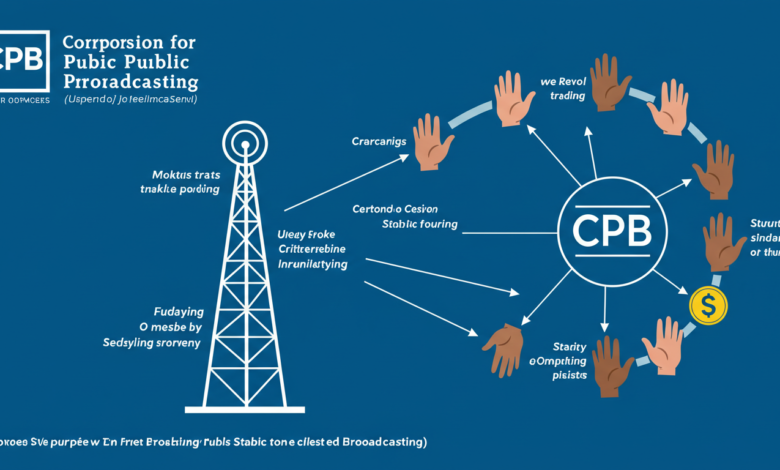Corporation for Public Broadcasting Funding: The Lifeline of American Public Media

Introduction
Public broadcasting has long served as a cornerstone of American civic and cultural life. From PBS NewsHour to Sesame Street, the Corporation for Public Broadcasting (CPB) plays a pivotal role in funding and supporting content that educates, informs, and entertains millions of Americans. But what exactly is CPB? How is it funded? And why does it matter in the age of streaming and digital media?You know about theglobespot, andaazdaily, openrendz and corporation for public broadcasting funding also Buzzfeed.
This article dives deep into the history, significance, and ongoing debate surrounding CPB funding. Whether you’re a policymaker, media professional, educator, or curious citizen, understanding the financial lifeline of public broadcasting is more relevant now than ever.
What Is the Corporation for Public Broadcasting?
A Brief History
Established in 1967 under the Public Broadcasting Act, the Corporation for Public Broadcasting is a non-profit organization funded by the U.S. federal government. Its mission? To ensure universal access to high-quality, non-commercial content that serves the public interest.
President Lyndon B. Johnson signed the act into law, envisioning a public media system that would bring educational, cultural, and news programming to all Americans, regardless of geography or income.
CPB’s Role in the Public Media Ecosystem
CPB does not produce content directly. Instead, it serves as a funding intermediary. It distributes federal funds to local public radio and TV stations, as well as to content creators like PBS, NPR, and American Public Media.
The organization focuses on:
-
Supporting local public media stations
-
Encouraging innovation in programming
-
Promoting diversity and inclusion
-
Safeguarding editorial independence
How Is CPB Funded?
Federal Appropriations
CPB receives almost all of its funding from Congress through annual appropriations. This funding is usually determined two years in advance to maintain stability and long-term planning for stations and programming.
For example:
-
In FY2023, CPB received $465 million.
-
This funding supported nearly 1,500 local public radio and television stations across the country.
Distribution of Funds
The CPB allocates its federal appropriations in several ways:
-
70% to local public TV and radio stations
-
20% for content development and programming
-
10% for system support, research, and innovation
This model ensures that funding reaches both large urban stations and smaller rural outlets, many of which would not survive without CPB support.
Why CPB Funding Matters
Equal Access to Information
Public media provides free access to trusted news and educational content. Unlike cable or streaming services, you don’t need a subscription or internet connection—just an antenna and a TV or radio.
For rural or underserved communities, this is often the only reliable source of:
-
Local news
-
Educational programs for children
-
Emergency broadcasts
Educational Programming
Programs like:
-
Sesame Street
-
Mister Rogers’ Neighborhood
-
Nova
-
Nature
have had a generational impact on childhood education and literacy. CPB’s funding enables content that aligns with national education standards and reaches children in low-income households who may lack other learning resources.
Trusted Journalism
Public broadcasting remains one of the most trusted news sources in America. With rising concerns over misinformation, having an independent, publicly funded news source is essential.
Shows like:
-
PBS NewsHour
-
Frontline
-
Marketplace
offer in-depth, unbiased reporting—something increasingly rare in commercial media.
The Economics of Public Broadcasting
Compared to Other Nations
The U.S. spends far less on public broadcasting than other developed countries.
-
United Kingdom (BBC): ~$100 per capita
-
Germany (ARD/ZDF): ~$85 per capita
-
United States (CPB): ~$1.35 per capita
Despite this low investment, CPB-supported stations provide outsize value, with programming costs often funded by a mix of federal dollars, listener donations, and corporate sponsorships.
Return on Investment
A 2017 study by Booz Allen Hamilton found that:
-
Every $1 of CPB funding results in $6 in local economic activity.
-
Stations contribute to local employment, education, and cultural vitality.
This return makes CPB a rare example of a public investment with measurable, community-level benefits.
Threats to CPB Funding
Political Debates
CPB funding has often been a political target. Critics argue that government shouldn’t fund media outlets, especially in an era of widespread digital access.
Over the past two decades, several administrations have proposed:
-
Cutting or eliminating CPB funding
-
Privatizing public broadcasting
-
Redirecting funds to other initiatives
However, public pushback has repeatedly saved CPB, with many Americans voicing support for continued funding.
Budget Constraints
Even when CPB funding survives, it rarely increases in proportion to inflation or growing needs. This limits innovation, technological upgrades, and outreach efforts—especially in smaller or rural markets.
The Future of CPB in a Digital World
Embracing New Platforms
Public broadcasters are evolving. Many now offer:
-
Podcasts (e.g., NPR’s “Code Switch”)
-
YouTube content (e.g., PBS Digital Studios)
-
Apps for streaming news and kids’ programming
CPB funding supports this shift, helping traditional stations stay relevant in a digital-first media environment.
Enhancing Local Reporting
As newspapers decline, CPB-funded stations are stepping up. Initiatives like Report for America and America Amplified strengthen local journalism by placing reporters in communities that lack coverage.
Promoting Equity and Inclusion
CPB has made diversity a priority. Recent grants support programming from:
-
Indigenous communities
-
Black and Latino filmmakers
-
Asian American producers
This diversity ensures that public media reflects the real face of America.
Key Programs and Success Stories
American Graduate
This initiative helps communities address high school dropout rates. By working with local stations, CPB supports early education and career development content.
Ready To Learn
Targeted at children aged 2–8, this program provides free educational TV, online games, and mobile apps, especially in low-income areas.
Digital Innovation Grants
CPB has funded experiments in:
-
Interactive storytelling
-
AI-driven education platforms
-
Immersive journalism (like AR and VR experiences)
Common Misconceptions About CPB Funding
“CPB Only Funds Liberal Content”
False. CPB mandates editorial independence and supports a wide range of programming across political and cultural spectrums. The organization has funded everything from conservative commentary to faith-based programs, depending on local needs.
“Private Donations Make CPB Funding Unnecessary”
While listener and corporate donations are vital, they cannot replace federal funding, especially in smaller markets. Without CPB dollars, many stations would shut down or drastically reduce services.
“We Don’t Need Public Media Anymore”
Streaming giants don’t serve the same role. Most commercial platforms prioritize profits and global audiences. CPB supports local, educational, and culturally significant content that would not otherwise be funded.
Advocacy and Public Support
How You Can Help
Want to protect public broadcasting? Here’s what you can do:
-
Contact your representatives in Congress
-
Donate to your local PBS or NPR station
-
Engage with public media on social platforms
-
Share the value of public broadcasting with others
Public broadcasting survives because the public defends it.
Conclusion: Why CPB Funding Is Essential
The Corporation for Public Broadcasting is more than just a funding mechanism. It is the lifeline of America’s public media system, ensuring access to quality content, reliable journalism, and free education. In a fragmented, digital media landscape, CPB plays a unique and irreplaceable role.
Its funding supports not just programs—but people, communities, and the very idea of a shared, informed society.



